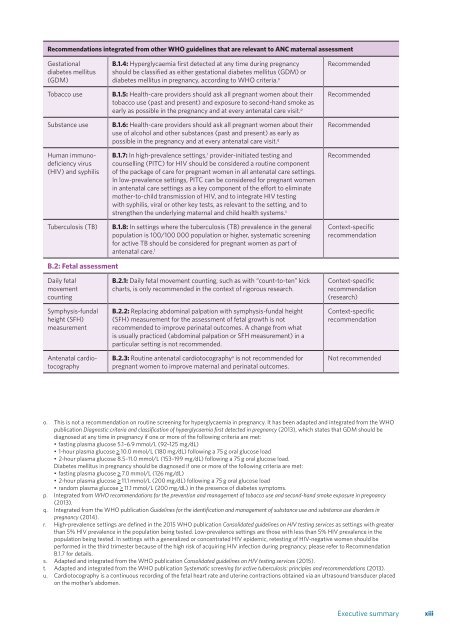WHO recommendations on antenatal care for a positive pregnancy experience
5pAUd5Zhw
5pAUd5Zhw
Create successful ePaper yourself
Turn your PDF publications into a flip-book with our unique Google optimized e-Paper software.
Recommendati<strong>on</strong>s integrated from other <str<strong>on</strong>g>WHO</str<strong>on</strong>g> guidelines that are relevant to ANC maternal assessment<br />
Gestati<strong>on</strong>al<br />
diabetes mellitus<br />
(GDM)<br />
Tobacco use<br />
Substance use<br />
Human immunodeficiency<br />
virus<br />
(HIV) and syphilis<br />
Tuberculosis (TB)<br />
B.1.4: Hyperglycaemia first detected at any time during <strong>pregnancy</strong><br />
should be classified as either gestati<strong>on</strong>al diabetes mellitus (GDM) or<br />
diabetes mellitus in <strong>pregnancy</strong>, according to <str<strong>on</strong>g>WHO</str<strong>on</strong>g> criteria. o<br />
B.1.5: Health-<strong>care</strong> providers should ask all pregnant women about their<br />
tobacco use (past and present) and exposure to sec<strong>on</strong>d-hand smoke as<br />
early as possible in the <strong>pregnancy</strong> and at every <strong>antenatal</strong> <strong>care</strong> visit. p<br />
B.1.6: Health-<strong>care</strong> providers should ask all pregnant women about their<br />
use of alcohol and other substances (past and present) as early as<br />
possible in the <strong>pregnancy</strong> and at every <strong>antenatal</strong> <strong>care</strong> visit. q<br />
B.1.7: In high-prevalence settings, r provider-initiated testing and<br />
counselling (PITC) <strong>for</strong> HIV should be c<strong>on</strong>sidered a routine comp<strong>on</strong>ent<br />
of the package of <strong>care</strong> <strong>for</strong> pregnant women in all <strong>antenatal</strong> <strong>care</strong> settings.<br />
In low-prevalence settings, PITC can be c<strong>on</strong>sidered <strong>for</strong> pregnant women<br />
in <strong>antenatal</strong> <strong>care</strong> settings as a key comp<strong>on</strong>ent of the ef<strong>for</strong>t to eliminate<br />
mother-to-child transmissi<strong>on</strong> of HIV, and to integrate HIV testing<br />
with syphilis, viral or other key tests, as relevant to the setting, and to<br />
strengthen the underlying maternal and child health systems. s<br />
B.1.8: In settings where the tuberculosis (TB) prevalence in the general<br />
populati<strong>on</strong> is 100/100 000 populati<strong>on</strong> or higher, systematic screening<br />
<strong>for</strong> active TB should be c<strong>on</strong>sidered <strong>for</strong> pregnant women as part of<br />
<strong>antenatal</strong> <strong>care</strong>. t<br />
Recommended<br />
Recommended<br />
Recommended<br />
Recommended<br />
C<strong>on</strong>text-specific<br />
recommendati<strong>on</strong><br />
B.2: Fetal assessment<br />
Daily fetal<br />
movement<br />
counting<br />
Symphysis-fundal<br />
height (SFH)<br />
measurement<br />
Antenatal cardiotocography<br />
B.2.1: Daily fetal movement counting, such as with “count-to-ten” kick<br />
charts, is <strong>on</strong>ly recommended in the c<strong>on</strong>text of rigorous research.<br />
B.2.2: Replacing abdominal palpati<strong>on</strong> with symphysis-fundal height<br />
(SFH) measurement <strong>for</strong> the assessment of fetal growth is not<br />
recommended to improve perinatal outcomes. A change from what<br />
is usually practiced (abdominal palpati<strong>on</strong> or SFH measurement) in a<br />
particular setting is not recommended.<br />
B.2.3: Routine <strong>antenatal</strong> cardiotocography u is not recommended <strong>for</strong><br />
pregnant women to improve maternal and perinatal outcomes.<br />
C<strong>on</strong>text-specific<br />
recommendati<strong>on</strong><br />
(research)<br />
C<strong>on</strong>text-specific<br />
recommendati<strong>on</strong><br />
Not recommended<br />
o. This is not a recommendati<strong>on</strong> <strong>on</strong> routine screening <strong>for</strong> hyperglycaemia in <strong>pregnancy</strong>. It has been adapted and integrated from the <str<strong>on</strong>g>WHO</str<strong>on</strong>g><br />
publicati<strong>on</strong> Diagnostic criteria and classificati<strong>on</strong> of hyperglycaemia first detected in <strong>pregnancy</strong> (2013), which states that GDM should be<br />
diagnosed at any time in <strong>pregnancy</strong> if <strong>on</strong>e or more of the following criteria are met:<br />
• fasting plasma glucose 5.1–6.9 mmol/L (92–125 mg/dL)<br />
• 1-hour plasma glucose > 10.0 mmol/L (180 mg/dL) following a 75 g oral glucose load<br />
• 2-hour plasma glucose 8.5–11.0 mmol/L (153–199 mg/dL) following a 75 g oral glucose load.<br />
Diabetes mellitus in <strong>pregnancy</strong> should be diagnosed if <strong>on</strong>e or more of the following criteria are met:<br />
• fasting plasma glucose > 7.0 mmol/L (126 mg/dL)<br />
• 2-hour plasma glucose > 11.1 mmol/L (200 mg/dL) following a 75 g oral glucose load<br />
• random plasma glucose > 11.1 mmol/L (200 mg/dL) in the presence of diabetes symptoms.<br />
p. Integrated from <str<strong>on</strong>g>WHO</str<strong>on</strong>g> <str<strong>on</strong>g>recommendati<strong>on</strong>s</str<strong>on</strong>g> <strong>for</strong> the preventi<strong>on</strong> and management of tobacco use and sec<strong>on</strong>d-hand smoke exposure in <strong>pregnancy</strong><br />
(2013).<br />
q. Integrated from the <str<strong>on</strong>g>WHO</str<strong>on</strong>g> publicati<strong>on</strong> Guidelines <strong>for</strong> the identificati<strong>on</strong> and management of substance use and substance use disorders in<br />
<strong>pregnancy</strong> (2014).<br />
r. High-prevalence settings are defined in the 2015 <str<strong>on</strong>g>WHO</str<strong>on</strong>g> publicati<strong>on</strong> C<strong>on</strong>solidated guidelines <strong>on</strong> HIV testing services as settings with greater<br />
than 5% HIV prevalence in the populati<strong>on</strong> being tested. Low-prevalence settings are those with less than 5% HIV prevalence in the<br />
populati<strong>on</strong> being tested. In settings with a generalized or c<strong>on</strong>centrated HIV epidemic, retesting of HIV-negative women should be<br />
per<strong>for</strong>med in the third trimester because of the high risk of acquiring HIV infecti<strong>on</strong> during <strong>pregnancy</strong>; please refer to Recommendati<strong>on</strong><br />
B.1.7 <strong>for</strong> details.<br />
s. Adapted and integrated from the <str<strong>on</strong>g>WHO</str<strong>on</strong>g> publicati<strong>on</strong> C<strong>on</strong>solidated guidelines <strong>on</strong> HIV testing services (2015).<br />
t. Adapted and integrated from the <str<strong>on</strong>g>WHO</str<strong>on</strong>g> publicati<strong>on</strong> Systematic screening <strong>for</strong> active tuberculosis: principles and <str<strong>on</strong>g>recommendati<strong>on</strong>s</str<strong>on</strong>g> (2013).<br />
u. Cardiotocography is a c<strong>on</strong>tinuous recording of the fetal heart rate and uterine c<strong>on</strong>tracti<strong>on</strong>s obtained via an ultrasound transducer placed<br />
<strong>on</strong> the mother’s abdomen.<br />
Executive summary<br />
xiii


